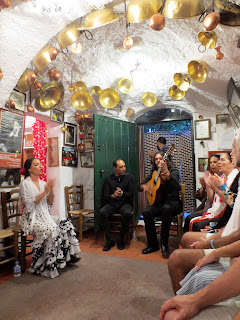 |
| Richard III no longer under a car park |
I have just spent four days this week in Leicester with my bestest friends in the whole world reliving the sights and sounds of a Leicester we first encountered 50 years ago. We met in the autumn of 1969 as fresh 18-year-olds away from home for the first time. My parents had taken me and my belongings up to Leicester and had just left for their return to London, leaving me there in my allocated Hall of Residence. I was feeling pretty bereft, when I bumped into the girl from the room next door who was equally abandoned. We teamed up to go into supper together that evening and the rest is history. She was studying French and I was studying German. She also went on to make friends with another girl also studying French and the three of us became the intrepid Musketeers, whose lives intertwined for fifty years afterwards through boyfriends, marriages, children and life. We've stayed in touch as best we can and, although we live a good many miles apart - one in Hertfordshire, one in Sussex and me in London, we try to visit one another or meet in London as often as life allows. As it was fifty years since we first met, I did not feel we could let this go uncelebrated so this week we booked into a hotel in the town to revisit old haunts, albeit it with creaking joints and less of the elan of youth.
Some things had changed. Some things hadn't. The university campus largely looked the same with a few new buildings added on - a Computer Centre for a start (I don't think the university even boasted one computer back in 1969). It also now has a Medical School built on after we left. We caused some merriment (or maybe it was pity) when everyone we encountered was told we had been students there 50 years ago. We searched for the famous paternoster lifts we used to hop on and off to discover they had been decommissioned last year. Such a shame as I wanted to hurl myself into one of the compartments and ride up and across the top as the video shows.
Much of the town was familiar, although we spotted building facades we swear weren't there 50 years ago, but must have been as they were Victorian or older. There were dragons all over the place (or heraldic wyverns, as we discovered they are called), that are symbolic of Leicester and found on weather vanes, carved into walls or decorating
the fountain in the Town Hall square.
 |
| Wyverns in Town Hall Square |
Our hotel was situated on New Walk - a pedestrianised street which led us all the way into the town centre each day. It was lined with beautiful Georgian or Queen Anne houses that must have many a story to tell. The original gas street lamps are still there, although now electrified.
 |
| New Walk - a delightful way to get into the town centre |
 |
| Complete with original gas lamps |
The most poignant moment of our visit came when we revisited our old Hall of Residence. It is no longer a Hall but has been turned into a Conference Centre. With trepidation, we entered the site, imagining all sorts of ghastly changes, but found it much the same. We even managed to get inside the block where we had our rooms, although the rooms (more like cells) had been knocked into one another to make them larger and allow for en suite bathrooms, something we never had the luxury of. We went into the old Junior Common Room to find it was now a coffee bar, but had some old photos in picture frames on the walls of how it had once looked and how we had remembered it. We were part of its history! This spiral staircase is still there - a cause of joy for us, as that is where one of us singed our hair holding a candle to provide light for the other two sitting on the step below playing guitars to a crowd below.







































